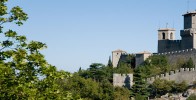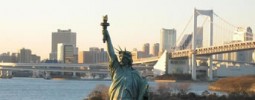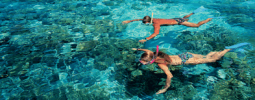San Marino is a country situated in the Apennine Mountains. San Marino is a landlocked enclave, completely surrounded by Italy. It borders to the Italian region Emilia Romagna to the north-east and Marche Montefeltro to the south-west. It is one of the smallest countries in the world, its total area is just 24 square miles. The capital is City of San Marino but the largest city is Dogana. San Marino is divided into nine municipalities, known locally as castelli.
San Marino has a parliamentary representative democratic republic, with the captains regent as head of state. Executive power is exercised by the government, the executive, the legislative power is vested in both the government and the Great and General Council. The Grand and General Council is the parliament of San Marino, it has 60 elected members. Social and political trends of the Republic are into line with those of Italy.
San Marino is just a little country, but it has a lot of beautiful buildings. Palazzo Pubblico is a Romanesque building in the Gothic Revival style. It is built on the foundations of the original “Parva Domus comunis”, architect Francesco Azzurri designed it in 1894. Having been restored by the architect Game Aulenti, the building was recently reopened. Another beautiful building is the Guaita fortress, the first fort built in the XI century and restored several times. Some of the rooms were used as a prison. On the left side of the entrance is the Chapel of the Rocca, which is dedicated to Saint Barbara. And then there is Cesta fortress, the second fort, it dates back to the XIII century and is on the high peak of Mount Titano. The Museum of weapons, a collection of weapons from the XIII to the XIX century, is housed there. The third fort, Montale fortress, is a watchtower. It can only be viewed from the outside, it provides a highly suggestive panorama.
San Marino cuisine combines traditions with quality, to keep alive the huge rural heritage of the country. It contains for example tagliatelle, ravioli, cappelletti, passatelli, roast meats and extra-virgin olive oil. Famous are their red wines, Brugneto and Tessano aged in large cherry wood barrels or in oak barriques, or still white wines, Biancale and Roncale.
San Marino has many traditions and culture festivals, which are wonderful to experience, such as: The changing of uniformed guards of the fort, performed at the Palazzo Pubblico in Piazza della Libertà, This ceremony is performed every half hour from 8:30 to 6: 30 hours during the summer months.. This Guardia di Rocca guard, was founded in 1754 and has two departments, the uniformed guards who guard the borders and public order and the Compagnia d’Artiglieria for national holidays and ceremonies. The guards of the fort on duty and during the changing of the guard wear beautiful uniforms with a dark green jacket decorated with red and white braids, red pants with a green stripe and a red hat with pom-pom and white spats. For the ceremony they also have gold epaulets and a leather helmet with red and white ostrich feathers.
The San Marino Crossbowmen’s Federation ,called The Federazione Balestrieri Sammarinese, was founded in 1956 thanks to its Chairman and Founder, Prof. Giuseppe Rossi. In ancient times it was the crossbow the city walls and the freedom of the Republic of San Marino defended. To ensure that the archers were in good shape it was found that once a year, on September 3, a festival dedicated to the founder of San Marino would be celebrated with the “Palio delle Balestre Grandi. This tradition is still continuing today, the ‘Palio’ is even bigger with costumed figures, musicians and flag-wavers to complete the pageantry of the crossbow competition.
There are no frontier formalities, anyone visiting Italy with a visa can enter San Marino. In Tourist Information Office, you can get your passport stamped.









